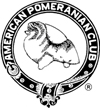Note: This is not the current version of the breed standard.
Appearance – The Pomeranian in build and appearance should be a compact, short-coupled dog, well-knit in frame. He should exhibit great intelligence in his expression, docility in his disposition, and activity and buoyancy in his deportment, and be sound in action.
Head – The head should be wedge-shaped, somewhat foxy in outline, the skull being slightly flat, large in proportion to the muzzle. In its profile it has a little stop which must not be too pronounced, and the hair on the head and face must be smooth or short-coated The muzzle should finish rather fine. . The teeth should meet in a scissors grip, in which part of the inner surface of the upper teeth meets and engages part of the outer surface of the lower teeth. This type of bite gives a firmer grip than one in which the edges of the teeth meet directly, and is subject to less wear. The mouth is considered overshot when the lower teeth fail to engage the inner surfaces of the upper teeth. The mouth is undershot when the lower teeth protrude beyond the upper teeth. One tooth out of line does not mean an undershot or overshot mouth. Eyes – The eyes should be medium in size, rather oblique in shape, not set too wide apart, or too close together, bright and dark in color. The eye rims of the blues and browns are self-colored. In all other colors the eye rims must be black. Ears – The ears should be small, not set too far apart or too low down, and carried perfectly erect, and should be covered with soft, short hair. Trimming unruly hairs on edges of ears permissible. Nose – Should be self-colored in blues and browns. In all other colors should be black.
Neck and Shoulders – The neck rather short, well set in, and lionlike, covered with a profuse mane and frill of long, straight hair sweeping from the underjaw and covering the whole of the front part of the shoulders and chest as well as the top part of the shoulders. The shoulders must be clean and laid well back.
Body – The back must be short and level, and the body compact, being well ribbed up and rounded. The chest must be fairly deep. Legs – The forelegs must be well feathered and perfectly straight, of medium length and strength in due proportion to a well-balanced frame. The feet small, compact in shape, standing well up on toes. The hind legs and thighs must be well feathered down to the hocks, and must be fine in bone and free in action. Trimming around the edges of the toes and up the back of the legs to the first joint is permissible. Tail – The tail is characteristic of the breed, and should be turned over the back and carried flat, set high. Is is profusely covered with long, spreading hair.
Coat – There should be two coats, an under- and an over coat; the first a soft, fluffy undercoat, and the other a long, perfectly straight and glistening coat covering the whole body, being very abundant around the neck and forepart of the shoulders and chest where it should form a frill of profuse, standing-off, straight hair extending over the shoulders. The hindquarters should be clad with long hair or feathering from the top of the rump to the hocks. The texture of the guard hairs must be harsh to the touch.
Color – Twelve colors, or color combinations, are permissible and recognized, namely, black, brown, chocolate, beaver, red, orange, cream, orange-sable, wolf-sable, blue, white, and parti-color. The beaver color is a dark beige. A parti-color dog is white with orange or black color distributed in even patches on the body, with white blaze on head desirable. Where whole-colored and parti-colored Pomeranians compete together, the preference should, other points being equal, be given to the whole-colored specimen. Sable-colored dogs must be shaded throughout as uniformly as possible, with no self-colored patches. In orange-sable, the under coat must be a light tan with deeper orange guard hairs ending in black tippings. In wolf-sable, the under coat is light gray with a deeper shade of steel-gray guard hairs ending in black tippings. A shaded muzzle on sables is permissible, but a black mask on sables is a minor fault. Orange Pomeranians must be self-colored throughout, with light shadings of the same tone (not white) breechings permitted. A black mask on an orange Pomeranian is a major fault. White hairs on black, brown, blue or sable Pomeranians are objectionable. Tinges of lemon or any other color on white dogs are objectionable. The above colors, as described, are the only allowable colors or combination of colors for Pomeranians.
Size – The weight of a Pomeranian for exhibition is 3 pounds to 7 pounds. The ideal size for show specimens is from 4 to 5 pounds.
Classification – The classes for Pomeranians may be divided by color in open classes as follows: Black and brown; red, orange, or cream; sable. Any other allowable color.
Faults
Major – Round, domey
skull. Too large ears. Undershot. Pink eye
rims. Light or Dudley nose. Out at elbows or
shoulders. Flat-sided dogs. Down in
pasterns. Cowhock. Soft, flat, open coat.
Whole-colored dogs with white chest, or
white foot or leg. Black mask on an orange.
Objectionable –
Overshot. Large, round or light eyes. High
or low on legs. Long toes. Too wide in hind
legs. Trimming too close to show date. Tail
set too low on rump. Black, brown, blue and
sable should be free from white hairs.
Whites should be free from lemon or any
other color. Black and tan. Underweight or
overweight.
Minor – Must be
free from lippiness, wide chest. Tail should
not curl back. Black mask on sable. White
shadings on orange.
Approved April 12, 1960

